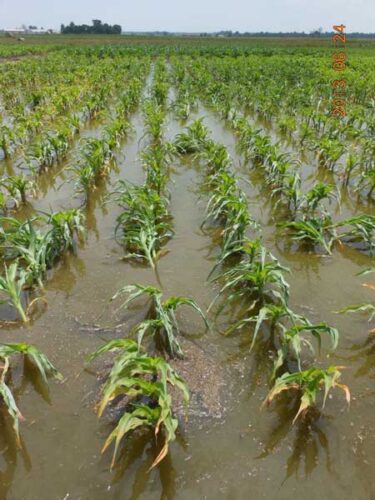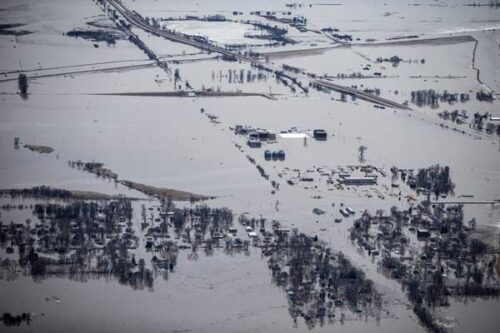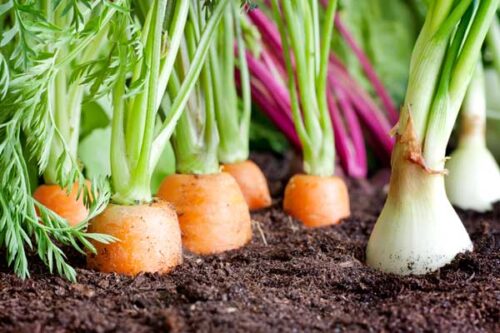Global Food Security
Here is a basic page layout with no sidebarGlobal food security is defined as “perceived and physical access to food supplies sufficient to meet basic needs and preferences at every level—individual, community, state, and global,” according to the U.S. National Intelligence Council in coordination with the CIA, National Security Agency, Defence Intelligence Agency and other high-level U.S. governmental departments and agencies.

Flooded cornfields in the U.S. Midwest

Flooded cornfields in the U.S. Midwest
A 2015 combined report from these agencies concluded that food insecurity will increase over the next 10 years in countries of strategic importance to the U.S. because of complications in growing and producing food, transportation, and market disruptions. This is due to increased threats from climate change, crop failures, extreme weather events like category 5 hurricanes, diseases such as the Coronavirus plaguing China, people moving to cities, constraints on land and water, and environmental degradation.
In addition, the World Economic Forum reports that the demand for food will increase 60% by 2050 due to the global population increasing to 9 billion people. And as populations become wealthier, the demand for meat and dairy increases.
The National Intelligence Council report states that these types of disruptions will contribute to political instability due to lack of access to food and the resulting hunger, starvation and famine that will most likely ensue. The Council’s recommendation is to continue with standard approaches such as producing more food and conserving water but to also add new strategies such as reducing food waste on and off the farm, conducting research into minor crops, and more.
Bottom line – our food system is currently facing a global crisis, especially with the growing effects of climate change. Countries already experiencing food insecurity will find the problem increasing, threatening the stability of the world as food shortages could lead to political unrest and, in turn, heightening the chance of conflict and wars breaking out over food and fresh water.
One More Threat: Bioterrorism
According to the Johns Hopkins Center for Public Health Preparedness, “Food terrorism is an act or threat of deliberate contamination of food for human consumption with chemical, biological or radionuclear agents for the purpose of causing injury or death to civilian populations and/or disrupting social, economic or political stability.”
This can be done through targeting:
- Livestock and crops on farm, while being raised/grown (called agroterrorism or agricultural bioterrorism)
- Processed food during the various stages of processing, manufacturing, storage, transport, distribution or service of the food

Flooded farmland in Iowa

Flooded farmland in Iowa
Plant Eat Share Helps Food Security
Since the terrorist attacks of 9/11, awareness of bioterrorism has increased but little has been done to minimize or eliminate the threats. The problem is exacerbated in the U.S. by the increasing consolidation and concentration of the food supply. By growing and raising food in one area, an easier target is created for terrorists.
Through Plant Eat Share, communities grow food locally in a completely decentralized manner, making it much more difficult to impossible for a terrorist to have any effect. The program will help mitigate effects from other disasters due to decreased transportation challenges. Even though efforts to plant food in public places and share healthy food for free will not stop or solve the complex food problems facing us, the programs starting around the world will help mitigate the impact and lack of certainty over access to food.
Lorem Ipsum Dolor
Nunc et vestibulum velit. Suspendisse euismod eros vel urna bibendum gravida. Phasellus et metus nec dui ornare molestie. In consequat urna sed tincidunt euismod. Praesent non pharetra arcu, at tincidunt sapien. Nullam lobortis ultricies bibendum. Duis elit leo, porta vel nisl in, ullamcorper scelerisque velit. Fusce volutpat purus dolor, vel pulvinar dui porttitor sed. Phasellus ac odio eu quam varius elementum sit amet euismod justo.
Lorem Ipsum Dolor
Nunc et vestibulum velit. Suspendisse euismod eros vel urna bibendum gravida. Phasellus et metus nec dui ornare molestie. In consequat urna sed tincidunt euismod. Praesent non pharetra arcu, at tincidunt sapien. Nullam lobortis ultricies bibendum. Duis elit leo, porta vel nisl in, ullamcorper scelerisque velit. Fusce volutpat purus dolor, vel pulvinar dui porttitor sed. Phasellus ac odio eu quam varius elementum sit amet euismod justo.
Lorem Ipsum Dolor
Nunc et vestibulum velit. Suspendisse euismod eros vel urna bibendum gravida. Phasellus et metus nec dui ornare molestie. In consequat urna sed tincidunt euismod. Praesent non pharetra arcu, at tincidunt sapien. Nullam lobortis ultricies bibendum. Duis elit leo, porta vel nisl in, ullamcorper scelerisque velit. Fusce volutpat purus dolor, vel pulvinar dui porttitor sed. Phasellus ac odio eu quam varius elementum sit amet euismod justo.
Lorem Ipsum Dolor
Nunc et vestibulum velit. Suspendisse euismod eros vel urna bibendum gravida. Phasellus et metus nec dui ornare molestie. In consequat urna sed tincidunt euismod. Praesent non pharetra arcu, at tincidunt sapien. Nullam lobortis ultricies bibendum. Duis elit leo, porta vel nisl in, ullamcorper scelerisque velit. Fusce volutpat purus dolor, vel pulvinar dui porttitor sed. Phasellus ac odio eu quam varius elementum sit amet euismod justo.
Lorem Ipsum Dolor
Nunc et vestibulum velit. Suspendisse euismod eros vel urna bibendum gravida. Phasellus et metus nec dui ornare molestie. In consequat urna sed tincidunt euismod. Praesent non pharetra arcu, at tincidunt sapien. Nullam lobortis ultricies bibendum. Duis elit leo, porta vel nisl in, ullamcorper scelerisque velit. Fusce volutpat purus dolor, vel pulvinar dui porttitor sed. Phasellus ac odio eu quam varius elementum sit amet euismod justo.

